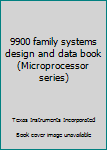9900 family systems design and data book (Microprocessor series)
No Synopsis Available.
Format:Paperback
Language:English
ISBN:0895120267
ISBN13:9780895120267
Release Date:January 1978
Publisher:Texas Instruments Incorporated
Length:1050 Pages
Weight:3.36 lbs.
Customer Reviews
1 rating
Hard to find info on an extinct chip set
Published by Thriftbooks.com User , 18 years ago
Introduced in 1976, the TMS9900 was one of the first true 16-bit microprocessors. It was designed as a single chip version of the TI 990 minicomputer series, and had a mature and well thought out design. It had a 15-bit address bus, a 16-bit data bus, and three internal 16-bit registers. One unique feature, though, was that all general purpose user registers were actually kept in external memory. A single workspace register (WP) pointed to the 16 register set in RAM, so when a subroutine was entered or an interrupt was processed, only the single workspace register had to be changed - unlike some CPUs which required dozens or more register saves before acknowledging a context switch. This was feasible at the time because RAM was often faster than the CPUs. It had good interrupt handling features and a very good instruction set. Serial I/O was available through address lines. In typical comparisons with the Intel 8086, the TMS9900 had smaller and faster programs. The only disadvantage was the small address space and need for fast RAM. A unique feature of the TMS9900 was the 'X' (or eXecute) assembly language instruction. This instruction was used to execute another instruction at an address pointed to by a register. In this way, code could execute in a non-sequential fashion. This is the only book available that is dedicated to designing systems with this old but interesting microprocessor family. In this book there are numerous illustrations and explanations about how to wire together all members of the TMS9900 family together, including their peripherals. The chips covered besides the microprocessor(s) themselves are: TMS9902 Asynchronous Communication Controller TMS9903 Synchronous Communication Controller TMS9909 Floppy Disk Controller TMS9914 GPIB Controller TMS9918 Video Controller TMS9927 Video Timer Controller There are numerous diagrams and plenty of information on how to integrate all of the covered IC's together into one system, as well as smaller systems including only one or two of the peripherals. If you follow this book you can practically reproduce the TMS99/4 home computer that featured them in the early 80's. If you have an old legacy system with these devices, you can finally figure out what's going on. I highly recommend it for anyone who still needs to work with this ancient chipset with some level of understanding.





